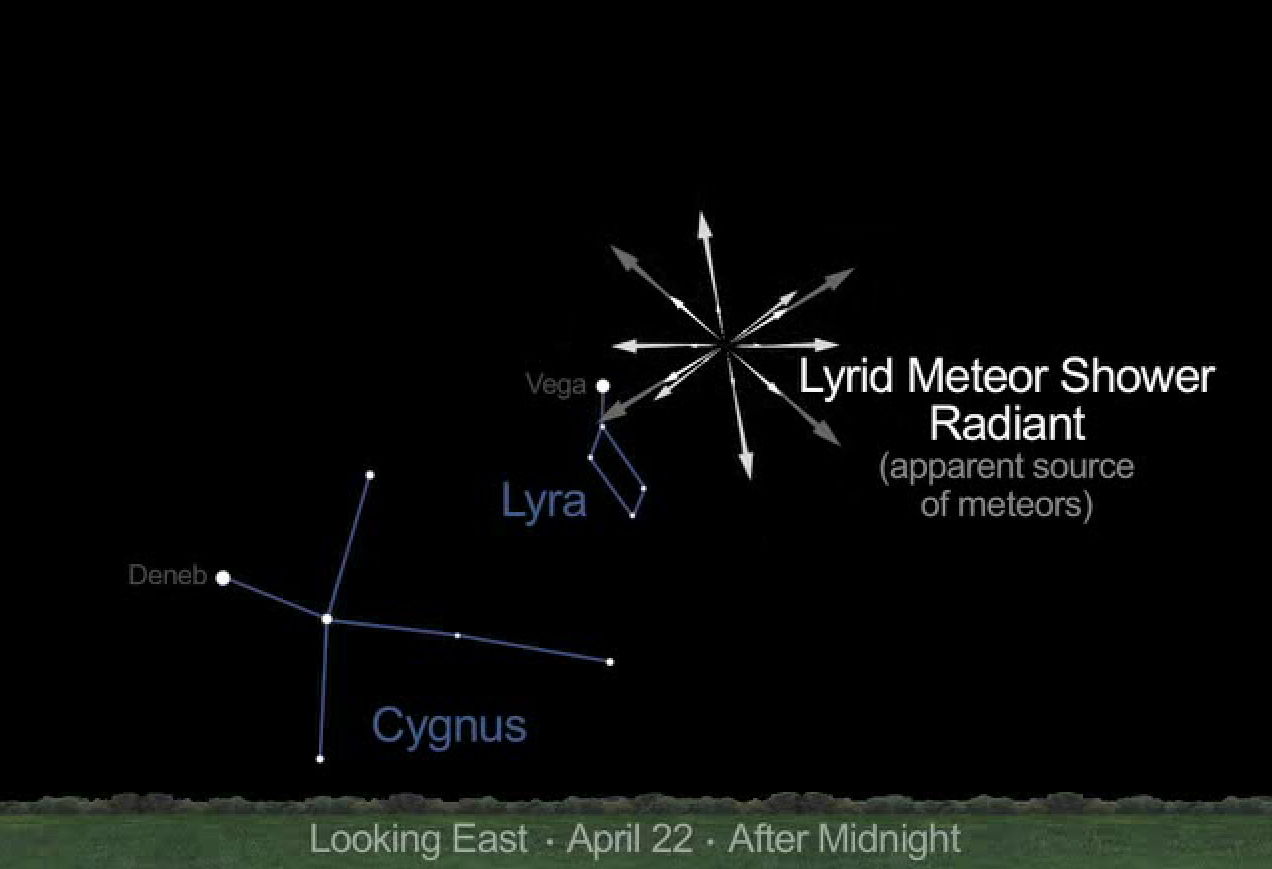Lyrid Meteor Shower Is Peaking Now

Editor's Note: If you missed the Lyrid meteor shower peak, then don't miss these spectacular photos of the celestial display by stargazers: Amazing Lyrid Meteor Shower Photos for 2013
The annual Lyrid meteor shower will peak tonight (April 21) and early Monday, but the moon's bright light may spoil the celestial fireworks display.
The Lyrid meteor shower occurs each year in mid-April when the Earth passes through a trail of dusty debris from the Comet Thatcher (C/1861 G1), which orbits the sun once every 415 years. Humans have been observing this particular meteor shower for at least 2,600 years.
Typically, the Lyrid meteor shower is a relatively faint stargazing event, though observers with clear dark skies away from city lights can usually spot up to 15 or 20 meteors an hour. The meteors appear to radiate out of the constellation Lyra (hence their name), which can be found in the eastern night sky tonight. [Amazing Lyrid meteor shower photos of 2012]
The moon is expected to spoil much of this year's Lyrid meteor display because it is currently in its bright gibbous phase, with the lunar disk nearly 85-percent illuminated, according to SPACE.com's stargazing columnist and meteorologist Joe Rao. That means that moonlight will likely wash out fainter Lyrid meteors, with only the brightest streakers being visible.
The best time to seek Lyrid meteors is actually in the wee hours of Monday morning (April 22) after the moon has set, but before the sun rises. This observing window opens at about 4 a.m. your local time and can close by about 4:30 a.m. At that time the Lyrid radiate will nearly directly overhead in the night sky, Rao explained.
Here are some tips to view the Lyrid meteor shower:
Get the Space.com Newsletter
Breaking space news, the latest updates on rocket launches, skywatching events and more!
Don't stare directly at Lyra: Focusing on the radiant point of the meteor shower sounds like a good idea, but the Lyrid that tend to occur there appear to have short tails and look more like unimpressive dots, NASA scientists have said. A better technique is to lie on your back (or a comfortable reclining chair) and look straight up.
Get comfortable: It can be a long, cold night without warm clothes or a blanket, depending on your location. Also, don't expect to just step outside and see some meteors. Make sure to give yourself at least 40 minutes to allow your eyes to adjust to the darkness.
Get away from city lights: They really can spoil a meteor shower, and this year that potential is doubled since the moon is already interfering with the display.

The Lyrid meteor shower is not the only celestrial event occuring this week. On Thursday (April 25) the moon will pass through part of the Earth's shadow in a partial lunar eclipse. The eclipse will be primarily visible in its entirety from parts of eastern Europe or Africa, central Asia and western Australia, according to NASA eclipse expert Fred Espenak.
Editor's note: If you snap a great photo Lyrid meteor shower that you'd like to share for a possible story or image gallery, send photos, comments and your name and location to managing editor Tariq Malik at spacephotos@space.com.
Email Tariq Malik at tmalik@space.com or follow him @tariqjmalik and Google+. Follow us @Spacedotcom, Facebook and Google+. Original article on SPACE.com.
Join our Space Forums to keep talking space on the latest missions, night sky and more! And if you have a news tip, correction or comment, let us know at: community@space.com.

Tariq is the Editor-in-Chief of Space.com and joined the team in 2001, first as an intern and staff writer, and later as an editor. He covers human spaceflight, exploration and space science, as well as skywatching and entertainment. He became Space.com's Managing Editor in 2009 and Editor-in-Chief in 2019. Before joining Space.com, Tariq was a staff reporter for The Los Angeles Times covering education and city beats in La Habra, Fullerton and Huntington Beach. In October 2022, Tariq received the Harry Kolcum Award for excellence in space reporting from the National Space Club Florida Committee. He is also an Eagle Scout (yes, he has the Space Exploration merit badge) and went to Space Camp four times as a kid and a fifth time as an adult. He has journalism degrees from the University of Southern California and New York University. You can find Tariq at Space.com and as the co-host to the This Week In Space podcast with space historian Rod Pyle on the TWiT network. To see his latest project, you can follow Tariq on Twitter @tariqjmalik.









